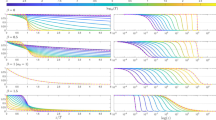Abstract
The problem concerned with mixing of mutually soluble liquids in turbulent flow in a pipe [1–11] is considered. To describe the distribution of concentration in the region of mixture, taken average across the section of the pipe, we use a model based on a one-dimensional model of the type of heat-conduction equation with an effective coefficient which, as tests show, is different from the coefficients of molecular and turbulent transfer. The dimensionless value of this coefficient depends on a number of parameters, such as the Reynolds number calculated for one of the liquids, roughness, ratio of the densities and viscosities of the liquids, as well as on the concentration, gradients of concentration, etc. These relationships can be established either by means of tests or on the basis of theoretical consideration of the mixing phenomenon. In this paper we theoretically derive a dispersion model with an effective diffusion coefficient which depends on Reynolds and Schmidt numbers, as well as on roughness.
Similar content being viewed by others
Literature cited
H. Kramers and K. Vestertern, Chemical Reactors, Their Calculation and Control [Russian translation], Khimiya, Moscow (1967).
G. Taylor, “The dispersion of matter in turbulent flow through a pipe,” Proc. Roy. Soc., Ser. A,223, No. 1155 (1954).
L. E. Flint and P. Eisenklam, “Dispersion of matter in transitional flow through straight tubes,” Proc. Roy. Soc., Ser. A,315, No. 1523, 519–533 (1970).
V. A. Yufin, “Mixing during successive pump-over of oil and oil products in pipe lines,” Neft. Khozvo, No. 8 (1957).
A. K. Gallyamov and V. I. Maron, “On the value of the effective coefficient of turbulent diffusion,” Neft. i Gaz, No. 8 (1968).
K. D. Frolov, “Mixing of oil products with various viscosity in pipes,” Transport i Khranenie Nefti i Nefteproduktov, No. 12 (1964).
O. Levenspiel, “Longitudinal mixing of fluids flowing in circular pipes,” Industr. Engng. Chem.,50, No. 3 (1958).
V. S. Yablonskii, A. Sh. Asaturyan, and Kh. O. Khizgilov, “On turbulent diffusion in pipes,” Inzh.-Fiz. Zh., No. 3 (1960).
V. W. Goldschmidt and M. K. Householder, “Longitudinal dispersion for turbulent flow in pipes,” Industr. Engng. Chem. Fundam.,8, No. 1 (1969).
V. Ananthakrishnan, W. N. Gill, and A. J. Barduhn, “Laminar dispersion in capillaries,” Part 1, A. I. Ch. E. J.,11, No. 6 (1965).
L. J. Tichacek, C. H. Barkelew, and T. Baron, “Axial mixing in pipes,” A.I. Ch. E. J., 13, No. 4 (1957).
J. O. Hinze, Turbulence, McGraw-Hill, New York (1959).
W. G. Schlinger and B. H. Sage, “Material transfer in turbulent gas streams. Concentric flow,” Industr. Engng. Chem.,45, No. 3 (1953).
S. Lynn, W. H. Corcoran, and B. H. Sage, “Material transport in turbulent gas streams: radial diffusion in a circular conduit,” A. I. Ch. E. J., 13, No. 1 (1957).
M. D. Millionshchikov, Turbulent Flows in a Boundary Layer and in Pipes [in Russian], Nauka, Moscow (1969).
A. D. Al'tshul, Hydraulic Resistance [in Russian], Nedra, Moscow (1970).
Author information
Authors and Affiliations
Additional information
Translated from Zhurnal Prikladnoi Mekhaniki i Tekhnicheskoi Fiziki, No. 5, pp. 96–102, September–October, 1971.
Rights and permissions
About this article
Cite this article
Maron, V.I. Mixing of mutually soluble liquids in turbulent flow in a pipe. J Appl Mech Tech Phys 12, 714–719 (1971). https://doi.org/10.1007/BF00851125
Received:
Issue Date:
DOI: https://doi.org/10.1007/BF00851125



